
by Sandra Gulland | Jan 30, 2015 | Adventures of a Writing Life |
Remember the first photos of Earth from space? It created a sea-change in our perspective.
As a child, my father found it amusing how disturbed I was by the idea of infinity. I am challenged anew, and in a rather marvellous way, seeing this amazing NASA video.
The word “perspective” has many meanings. It is an old word, dating from 1300s.
1387: Aristotle..made..problemys of perspective [L. perspectiva problemata] and of methaphesik.
a1661 W. Brereton (1844) 60 Wm. Daviseon offered to furnish me with a couple of these perspectives, which shew the new-found motion of the stars about Jupiter.
1692 tr. C. de Saint-Évremond 280 By the means of great Perspectives, which Invention becomes more perfect every Day, they discover new Planets.
1605 Bacon ii. sig. Hh3, We haue endeauoured in these our Partitions to observe a kind of perspectiue, that one part may cast light vpon another.
It’s this last, the sense of “putting things in perspective,” that this NASA video vividly evokes for me. What do our own small lives matter, after all?
I am consoled by William Blake’s lines from Auguries of Innocence:
To see a World in a Grain of Sand
And a Heaven in a Wild Flower,
Hold Infinity in the palm of your hand
And Eternity in an hour.
I begin each day working to create a world on the page. Every age has its moment of wonder, of awe, of expanded perspective. I’m wondering what that moment was for Hortense at the end of the 18th century.
Worth reading …
The Incident of the Fly Swatter, a blog post on Wonders & Marvels, on some historical perspective on the relationship between France and the Muslim world.
by Sandra Gulland | Nov 21, 2014 | Baroque Explorations |

It’s simply astonishing what one can now find on-line. In the way of any wander through library stacks, I came upon this title on Gallica.bnf.fr, the French national library on-line:
Tableau historique, littéraire et politique de l’an VI de la Républic française.
Of course it was not at all what I was looking for, but although “You can’t always get what you want, but if you try sometime, you find you get what you need.” :-)
I love the way the digital book opens with its cover:
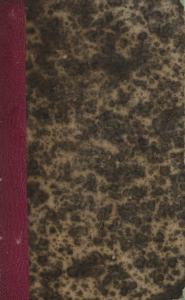
And then turns to the marbled end-paper:
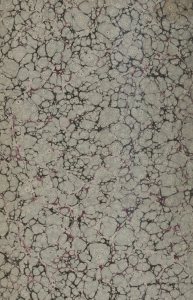
Here’s a crop of the title page:
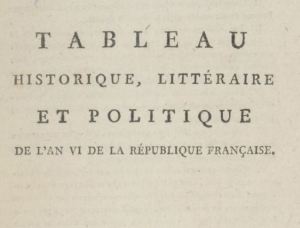
(You can almost feel the rich texture of the paper.)
And then, the first chapter division:
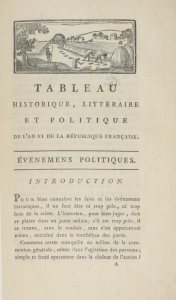
What caught my attention “leafing” through this book was the section on legislation, a daily account of laws passed in the years 1798-1799.
They are very detailed: they needed to be. The French government was (once again) creating a government from scratch. Laws mentioned cover passport regulations, import duties, the re-establishment of a national lottery, the legislateurs’ own schedule (they will no longer meet on décadis (the end of the 10-day week), patents, manufacture of goods, the “uniform” to be worn by the members of the legislature …
“…habit français, couleur bleu national, croisé et dépassant le genou. Ceinture de soie tricolore, avec des franges d’or. Manteau écarlate à la grecque, orné de broderie en laine. Bonnet de velours, portant une aigrette tricolore.” – page 142
Alas, I am unable to find an illustration of this costume. No doubt they were somewhat more circumspect than those from 1796. Below left, Executive Director from 1796, compared to Napoleon’s uniform of choice as First Consul on the right:
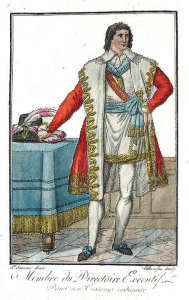

The legal record is many pages long, but I’ll note a few:
One law passed condemns to death those who rob by force or violence. This is significant because violent crime had become rampant.
Marriages (which must be civil) could only be held on décadis.
One significant law, passed 12 Nivose, an VIII (January 1, 1799), declares that Blacks born in Africa or in foreign colonies, and transferred to French islands, were free as soon as they step foot on French soil. The Revolutionary government had several years before outlawed slavery in France, but I don’t believe that it had gone so far as to declare it illegal in its colonies. (I should note that Napoleon will eventually reinstate slavery in the French colonies, and no: it was not Josephine’s doing.)
It’s delightful how worthwhile procrastinating can be. I found an excellent Revolutionary calendar (more on that later), learned the date when there was an eclipse of the moon, what the new national fêtes were to be, and much, much more.
by Sandra Gulland | Sep 6, 2014 | Baroque Explorations |
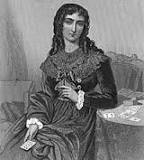
Part of my research for writing my first Young Adult novel about Josephine‘s daughter Hortense involves fortune-telling, mysticism and communing with ghosts. Yes, all quite delicious!
Madame Lenormand (or Le Normand) was a famous fortune-teller of this time, a high-society favourite known as “The Sibyl of the Faubourg Saint-Germain.”
A card method of fortune-telling attributed to her is extremely popular now. Type “Lenormand” in Google and you will see what I mean. The Madame Lenormand Fortune Teller is a site where you can get a (free) reading on-line using a variety of cards: fairly awesome! This is a great way to get to know the cards and the different ways of reading them.

At the Lenormand on-line Museum you can look at all the cards, both ancient and new.
Once you start exploring this realm, it’s a bit overwhelming. I appear to have just signed up for a free telephone reading! I’m no sibyl, but I predict that they will want my credit card number first.
For more on this subject: Origins of Playing Card Divination.
Since writing this post, I’ve learned a great deal more about Madame Lenormand and her cards. For one thing, she was quite the entrepreneur, writing and publishing vast amounts. I read several books on her system, and made a practice of “throwing” my cards every day. In short, I became a bit addicted! The cards are often called “The Game of Hope”—and they’ve become central to the novel I’m writing. In fact, the working title is The Game of Hope.
Books about The Game of Hope:

For information about Lenormand: A Wicked Pack of Cards by Ronald Decker, Therry Depaulis and Michael Dummett.
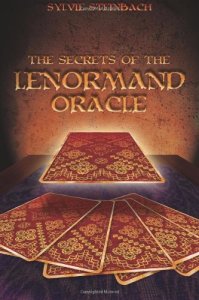
To learn how to read the cards, I like The Secrets of the Lenormand Oracle by Sylvie Steinbach.
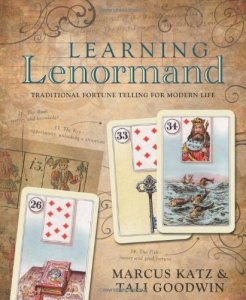
Another book, a bit more complex however, is Learning Lenormand by Marcus Katz and Tali Goodwin.
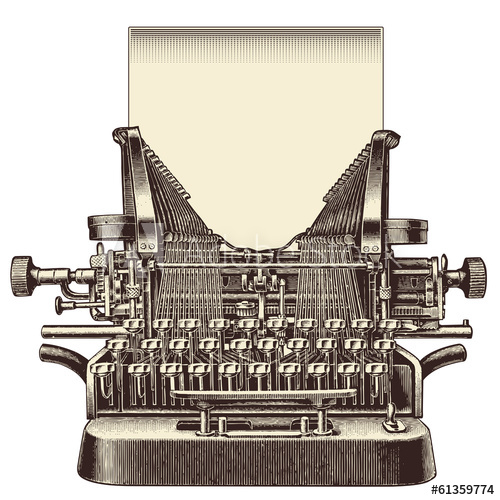
by Sandra Gulland | Jul 11, 2014 | Adventures of a Writing Life |
I explained in my last post what the Writers’ Blog Tour is about. Basically, writers answer the same four questions:
Why do I write what I do?
What am I working on?
How does my work differ from other work in its genre?
How does my writing process work?
I answered the first question yesterday, and so, for today, here’s the second:
What am I working on?
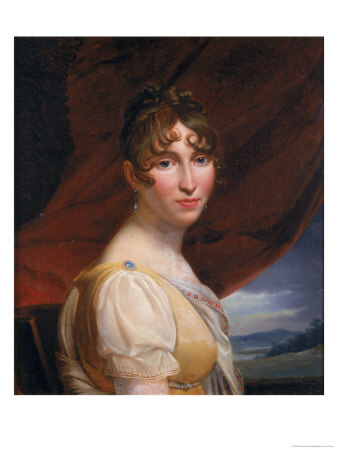
I’m back in the Napoleonic era after more than a decade away, writing about Josephine Bonaparte’s daughter Hortense. It’s a familiar world, but it’s also quite new to me, because this is a Young Adult novel. I’m finding it creatively stimulating to be tackling a new genre.
The novel is written from Hortense’s point-of-view during her teen years, and is therefore an entirely different perspective from that of her mother, who is the point-of-view character of my Josephine B. Trilogy.
Delving back into a once-very-familiar world has been an interesting—and pleasant—experience. The late 18th century feels so modern compared to the 17th! (The setting for my last two novels.)
Having previously immersed myself in the Napoleonic era for near-on two decades, one would think I wouldn’t have to do very much research. Wrong! There are new books and studies available, and there’s a ton more information on line. Although I have quite a leg-up (a 556-page timeline—single space, small type—for starters, and stacks and stacks of files), there is no such thing as no need to research. In any case, how can one resist?
Tomorrow: How does my work differ from other work in its genre? This, as you can imagine, is a thought-provoking question!
SaveSave
SaveSave
by Sandra Gulland | Dec 4, 2013 | Baroque Explorations |
I just this moment sent off the first draft of The Game of Love, the current working title of my first young adult novel about Josephine’s daughter Hortense. (It went to free-lance editor Allison McCabe, my first reader and editor.)
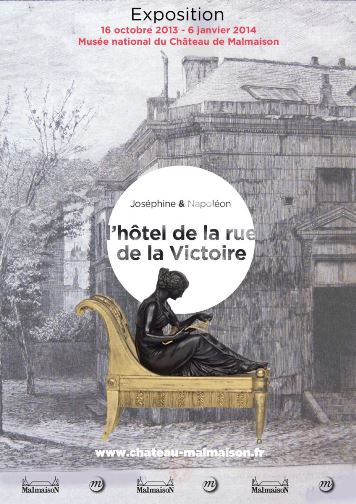
This morning I checked spelling before sending it off. In consulting Google on how to spell the name of Josephine and Napoleon’s little house in Paris, I discovered that there is now an exhibit at Malmaison about this house, providing information that is very hard to come by. Information I badly need! Plus this tempting bit: “Computer reconstructions and models bring this residence to life and let visitors view it on all sides.”
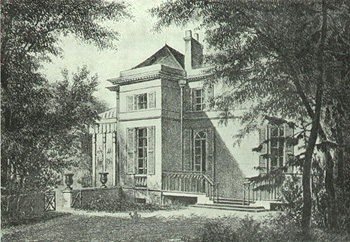
Torture! I so want to see it!
Luckily, with a little tenacious searching, I found an extensive pdf about the exhibition which one can read on Google Play. It reveals a great deal:
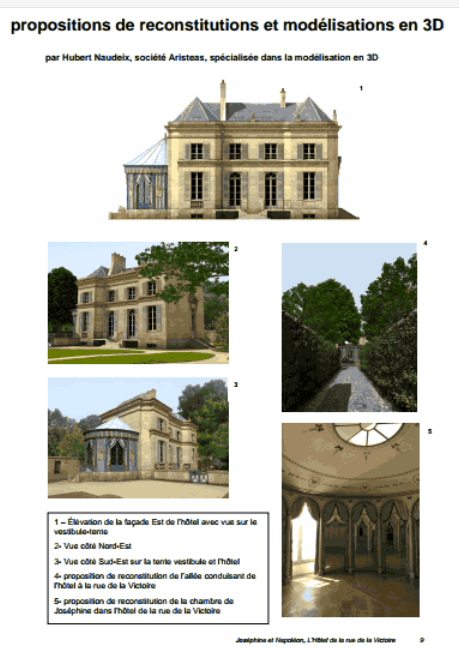
A map shows it’s location and the very long drive down to the house from the rue de la Victoire.
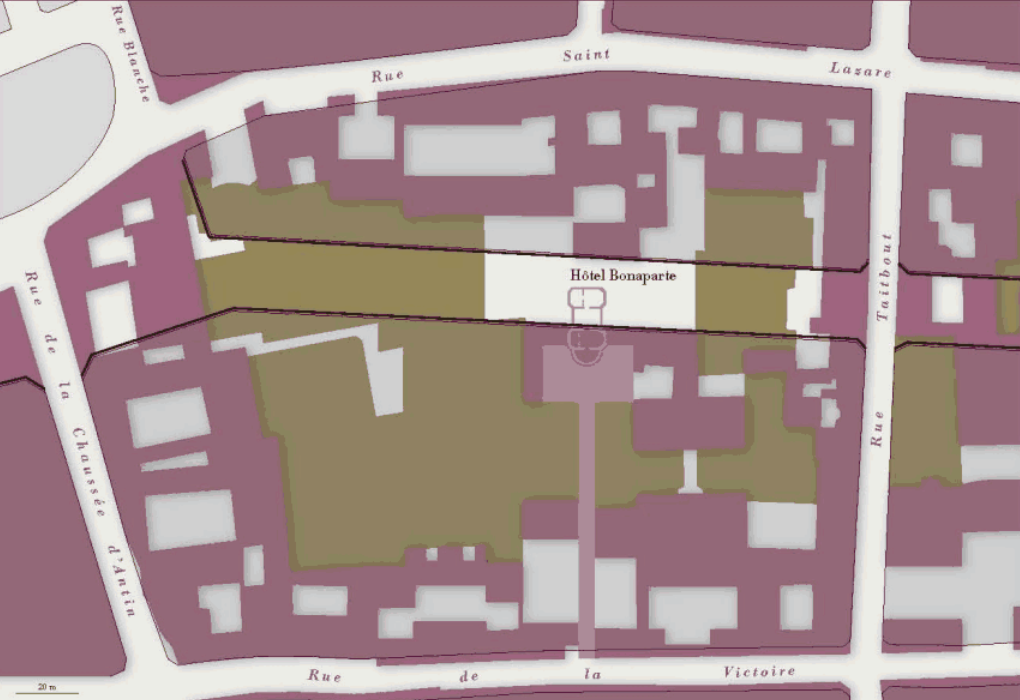
Another map shows the locations of other properties in the neighbourhood—but does not show a house belonging to Napoleon’s sister Pauline and her husband, although it is often claimed that they bought a house close-by. (Note to self: more research needed.)
But here is a treasure of a find: a table that becomes Josephine’s desk. A desk features significantly in my novel, and this may well be it.

The excitement of research!
SaveSave
SaveSave


















